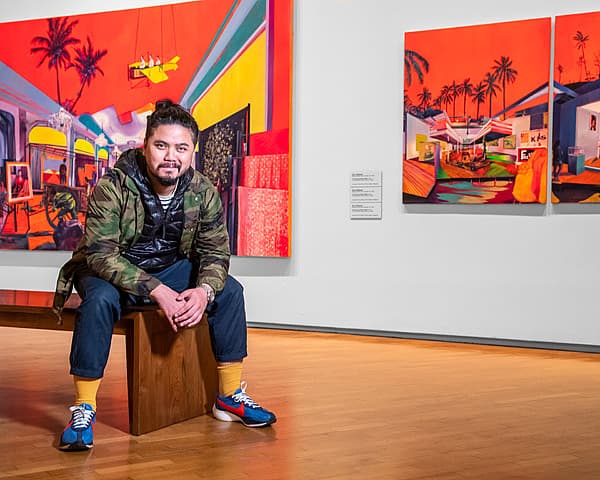Contemporary
worlds
Indonesia
Zico Albaiquni
Zico Albaiquni approaches painting by evoking moments in art history. He studies and interprets earlier genres and contexts, gathering motifs to probe fundamental questions about the role of artists and the circulation and function of art. In his theatrically laid-out compositions, Indonesian historical references and contemporary cultural icons coalesce across intersecting picture planes, bathed in a distinctive vibrant palette.
Featured prominently among landscapes peppered with disparate juxtapositions are paradigms of the Mooi Indië (Beautiful Indies) tradition, a form of imported European Romantic painting that dominated Indonesian art during the colonial era. Albaiquni has also been inspired by the social realism of S Sudjojono, likening the seminal Indonesian modernist’s criticisms of colonial painters’ exoticised archipelago landscapes and tropes of palm trees and mountains—which often populate the fluorescent backgrounds of Albaiquni’s works—to the circulation of kitsch tourist art and advertising today.
For evidently, the fine arts do not thrive in the Indies 2018 takes its title from a 1999 article by East Indies painting writer and researcher Koos van Brakel. It is set in a local painting shop, where Albaiquni places examples of gambar pemandangan, a landscape perspective teaching device, behind the distinctive columns of the Venice Biennale’s Arsenale exhibition space during Katharina Grosse’s 2015 display. These surround a nineteenth-century photograph of Papuan natives with misappropriated hand-painted feathers added to their headdress from the National Gallery of Australia’s Leo Haks collection.1
Ladies and gentlemen! Kami present, Ibu Pertiwi! 2018 borrows aspects from Sudjojono’s 1965 painting Kami present, Ibu Pertiwi (Stand guard for our Motherland) under palm trees from a painting by Raden Saleh, the most celebrated Indonesian artist of the Mooi Indië era. The interior is based on the traditional Indonesian textiles hung in the 2018 Festival couleurs d’Indonésie exhibition in Paris, while a group of Javanese men in a plane fly above, an image taken from an imaginatively staged photograph from 1919.
While collecting ideas from past genres, Albaiquni remains part of a new wave of Indonesian artists. He ventures beyond the remnant postcolonial views and socio-political motivations that informed his artistic predecessors, but also contemplates the traditional nature of pelukis (painter) in Indonesia, which draws connotations of community, ritual and spirituality. Combining these broad conceptual influences, Albaiquni experiments with questions of how the Indonesian landscape and its peoples have been represented in the past, and where Indonesian art, and he himself as an artist, fit within an internationalised art world today.
Tarun Nagesh
- The untitled, hand-coloured silver bromide photograph was taken in West Papua, Indonesia, and is included in the National Gallery’s Leo Haks Collection (2007.3039) which was assembled in Amsterdam between 1977 and 2007. The European man in the photograph has been tentatively identified as Father Henri Geurtjens by Raymond Corbey, Professor of Philosophy of Science and Anthropology, Leiden University, the Netherlands.

Zico Albaiquni
